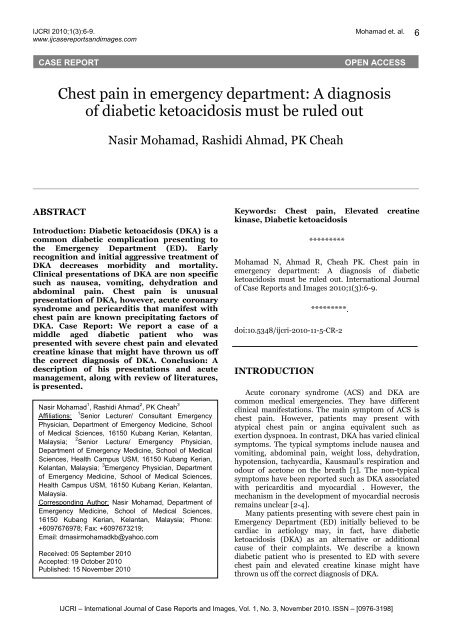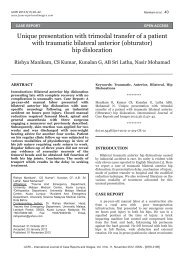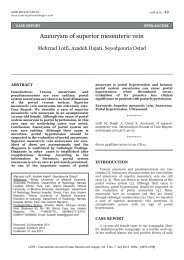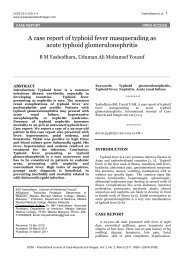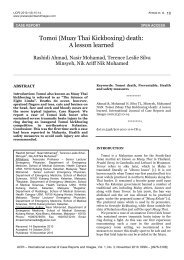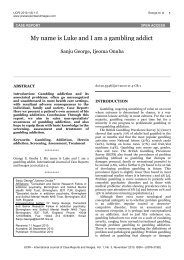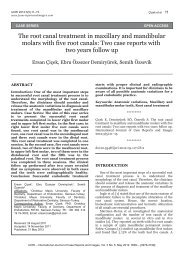Chest pain in emergency department - International Journal of Case ...
Chest pain in emergency department - International Journal of Case ...
Chest pain in emergency department - International Journal of Case ...
Create successful ePaper yourself
Turn your PDF publications into a flip-book with our unique Google optimized e-Paper software.
IJCRI 2010;1(3):6-9.<br />
www.ijcasereportsandimages.com<br />
Mohamad et. al.<br />
6<br />
CASE REPORT<br />
OPEN ACCESS<br />
<strong>Chest</strong> <strong>pa<strong>in</strong></strong> <strong>in</strong> <strong>emergency</strong> <strong>department</strong>: A diagnosis<br />
<strong>of</strong> diabetic ketoacidosis must be ruled out<br />
Nasir Mohamad, Rashidi Ahmad, PK Cheah<br />
ABSTRACT<br />
Introduction: Diabetic ketoacidosis (DKA) is a<br />
common diabetic complication present<strong>in</strong>g to<br />
the Emergency Department (ED). Early<br />
recognition and <strong>in</strong>itial aggressive treatment <strong>of</strong><br />
DKA decreases morbidity and mortality.<br />
Cl<strong>in</strong>ical presentations <strong>of</strong> DKA are non specific<br />
such as nausea, vomit<strong>in</strong>g, dehydration and<br />
abdom<strong>in</strong>al <strong>pa<strong>in</strong></strong>. <strong>Chest</strong> <strong>pa<strong>in</strong></strong> is unusual<br />
presentation <strong>of</strong> DKA, however, acute coronary<br />
syndrome and pericarditis that manifest with<br />
chest <strong>pa<strong>in</strong></strong> are known precipitat<strong>in</strong>g factors <strong>of</strong><br />
DKA. <strong>Case</strong> Report: We report a case <strong>of</strong> a<br />
middle aged diabetic patient who was<br />
presented with severe chest <strong>pa<strong>in</strong></strong> and elevated<br />
creat<strong>in</strong>e k<strong>in</strong>ase that might have thrown us <strong>of</strong>f<br />
the correct diagnosis <strong>of</strong> DKA. Conclusion: A<br />
description <strong>of</strong> his presentations and acute<br />
management, along with review <strong>of</strong> literatures,<br />
is presented.<br />
Nasir Mohamad 1 , Rashidi Ahmad 2 , PK Cheah 3<br />
Affiliations:<br />
1 Senior Lecturer/ Consultant Emergency<br />
Physician, Department <strong>of</strong> Emergency Medic<strong>in</strong>e, School<br />
<strong>of</strong> Medical Sciences, 16150 Kubang Kerian, Kelantan,<br />
Malaysia;<br />
2 Senior Lecture/ Emergency Physician,<br />
Department <strong>of</strong> Emergency Medic<strong>in</strong>e, School <strong>of</strong> Medical<br />
Sciences, Health Campus USM, 16150 Kubang Kerian,<br />
Kelantan, Malaysia; 3 Emergency Physician, Department<br />
<strong>of</strong> Emergency Medic<strong>in</strong>e, School <strong>of</strong> Medical Sciences,<br />
Health Campus USM, 16150 Kubang Kerian, Kelantan,<br />
Malaysia.<br />
Correspond<strong>in</strong>g Author: Nasir Mohamad, Department <strong>of</strong><br />
Emergency Medic<strong>in</strong>e, School <strong>of</strong> Medical Sciences,<br />
16150 Kubang Kerian, Kelantan, Malaysia; Phone:<br />
+6097676978; Fax: +6097673219;<br />
Email: drnasirmohamadkb@yahoo.com<br />
Received: 05 September 2010<br />
Accepted: 19 October 2010<br />
Published: 15 November 2010<br />
Keywords: <strong>Chest</strong> <strong>pa<strong>in</strong></strong>, Elevated creat<strong>in</strong>e<br />
k<strong>in</strong>ase, Diabetic ketoacidosis<br />
*********<br />
Mohamad N, Ahmad R, Cheah PK. <strong>Chest</strong> <strong>pa<strong>in</strong></strong> <strong>in</strong><br />
<strong>emergency</strong> <strong>department</strong>: A diagnosis <strong>of</strong> diabetic<br />
ketoacidosis must be ruled out. <strong>International</strong> <strong>Journal</strong><br />
<strong>of</strong> <strong>Case</strong> Reports and Images 2010;1(3):6-9.<br />
*********.<br />
doi:10.5348/ijcri-2010-11-5-CR-2<br />
INTRODUCTION<br />
Acute coronary syndrome (ACS) and DKA are<br />
common medical emergencies. They have different<br />
cl<strong>in</strong>ical manifestations. The ma<strong>in</strong> symptom <strong>of</strong> ACS is<br />
chest <strong>pa<strong>in</strong></strong>. However, patients may present with<br />
atypical chest <strong>pa<strong>in</strong></strong> or ang<strong>in</strong>a equivalent such as<br />
exertion dyspnoea. In contrast, DKA has varied cl<strong>in</strong>ical<br />
symptoms. The typical symptoms <strong>in</strong>clude nausea and<br />
vomit<strong>in</strong>g, abdom<strong>in</strong>al <strong>pa<strong>in</strong></strong>, weight loss, dehydration,<br />
hypotension, tachycardia, Kausmaul’s respiration and<br />
odour <strong>of</strong> acetone on the breath [1]. The non-typical<br />
symptoms have been reported such as DKA associated<br />
with pericarditis and myocardial . However, the<br />
mechanism <strong>in</strong> the development <strong>of</strong> myocardial necrosis<br />
rema<strong>in</strong>s unclear [2-4].<br />
Many patients present<strong>in</strong>g with severe chest <strong>pa<strong>in</strong></strong> <strong>in</strong><br />
Emergency Department (ED) <strong>in</strong>itially believed to be<br />
cardiac <strong>in</strong> aetiology may, <strong>in</strong> fact, have diabetic<br />
ketoacidosis (DKA) as an alternative or additional<br />
cause <strong>of</strong> their compla<strong>in</strong>ts. We describe a known<br />
diabetic patient who is presented to ED with severe<br />
chest <strong>pa<strong>in</strong></strong> and elevated creat<strong>in</strong>e k<strong>in</strong>ase might have<br />
thrown us <strong>of</strong>f the correct diagnosis <strong>of</strong> DKA.<br />
IJCRI – <strong>International</strong> <strong>Journal</strong> <strong>of</strong> <strong>Case</strong> Reports and Images, Vol. 1, No. 3, November 2010. ISSN – [0976-3198]
IJCRI 2010;1(3):6-9.<br />
www.ijcasereportsandimages.com<br />
Mohamad et. al.<br />
7<br />
CASE REPORT<br />
A 44-year-old man arrived at the Emergency<br />
Department (ED) triage counter scream<strong>in</strong>g <strong>in</strong> <strong>pa<strong>in</strong></strong> and<br />
hold<strong>in</strong>g his chest. He was immediately sent to the red<br />
zone. We were unable to get a proper history as he<br />
repeatedly compla<strong>in</strong>ed <strong>of</strong> severe central chest <strong>pa<strong>in</strong></strong> and<br />
shortness <strong>of</strong> breath. Initial focused exam<strong>in</strong>ation<br />
revealed he was <strong>in</strong> severe chest <strong>pa<strong>in</strong></strong>, restless,<br />
moderately dehydrated, dyspneic and tachypnoeic. His<br />
BMI was 26.2. His <strong>in</strong>itial blood pressure, heart rate,<br />
respiratory rate, oxygen saturation and temperature<br />
were 129/62 mmHg, 98 beats per m<strong>in</strong>ute, 28 per<br />
m<strong>in</strong>ute, 100% under room air and 37°C respectively.<br />
Electrocardiogram (ECG) revealed s<strong>in</strong>us tachycardia<br />
rhythm. All peripheral pulses were palpable and equal<br />
on both sides. Abdom<strong>in</strong>al exam<strong>in</strong>ation revealed s<strong>of</strong>t<br />
abdomen with mild tenderness over the epigastric<br />
area. Bowel sounds were normal (10/m<strong>in</strong>).<br />
Exam<strong>in</strong>ations <strong>of</strong> the cardiovascular and respiratory<br />
system were unremarkable.<br />
High flow oxygen via non rebreath<strong>in</strong>g mask was<br />
<strong>in</strong>stituted and an <strong>in</strong>travenous drip <strong>of</strong> normal sal<strong>in</strong>e<br />
accord<strong>in</strong>g to the protocol was <strong>in</strong>itiated. Soluble aspir<strong>in</strong><br />
300 mg, subl<strong>in</strong>gual glyceryl tr<strong>in</strong>itrate (GTN) 0.5mg<br />
and isosorbide d<strong>in</strong>itrate <strong>in</strong>fusion 10 mcg/m<strong>in</strong> were<br />
adm<strong>in</strong>istered. The chest <strong>pa<strong>in</strong></strong> was persistent despite<br />
the <strong>in</strong>itial treatment. The <strong>pa<strong>in</strong></strong> was controlled after 10<br />
mg <strong>of</strong> <strong>in</strong>travenous morph<strong>in</strong>e (titrat<strong>in</strong>g dose every 5<br />
m<strong>in</strong>utes). Intravenous midazolam <strong>of</strong> 2.5mg was also<br />
adm<strong>in</strong>istered to make him more calm and comfortable.<br />
He was treated as acute coronary syndrome (ACS).<br />
Intravenous hepar<strong>in</strong> accord<strong>in</strong>g to the protocol was<br />
adm<strong>in</strong>istered.<br />
Further history was obta<strong>in</strong>ed after the <strong>pa<strong>in</strong></strong> was<br />
controlled; it was sudden <strong>in</strong> onset, about one hour<br />
prior to admission. The patient claimed that he had<br />
<strong>in</strong>termittent, sudden central chest <strong>pa<strong>in</strong></strong>, radiat<strong>in</strong>g to<br />
the neck and epigastric area, last<strong>in</strong>g for a few m<strong>in</strong>utes,<br />
and relieved spontaneously for the past two days. He<br />
had difficulty <strong>in</strong> describ<strong>in</strong>g the nature <strong>of</strong> <strong>pa<strong>in</strong></strong>. The<br />
chest <strong>pa<strong>in</strong></strong> was associated with difficulty <strong>in</strong> breath<strong>in</strong>g<br />
and sweat<strong>in</strong>g. The <strong>pa<strong>in</strong></strong> was not precipitated by<br />
breath<strong>in</strong>g, exercise and food <strong>in</strong>take. He had a few<br />
occasions <strong>of</strong> vomit<strong>in</strong>g and low-grade fever for the last 3<br />
days. He did not seek any treatment from a general<br />
practitioner. He has been suffer<strong>in</strong>g from Type II<br />
diabetes mellitus s<strong>in</strong>ce 5 years and is currently on<br />
subcutaneous Actrapid <strong>in</strong>sul<strong>in</strong> (18 IU/18U/10U). For<br />
the past 2 weeks <strong>of</strong> fast<strong>in</strong>g month-Ramadhan, he did<br />
not take his daylight <strong>in</strong>sul<strong>in</strong> <strong>in</strong>jections s<strong>in</strong>ce he was<br />
fast<strong>in</strong>g and he was afraid that <strong>in</strong>sul<strong>in</strong> might cause him<br />
hypoglycemia. He is a non-smoker and has no history<br />
<strong>of</strong> ischemic heart disease or hypertension. However, he<br />
had family history <strong>of</strong> heart ailments and hypertension<br />
<strong>in</strong> his first degree relative.<br />
Serial electrocardiograms showed a normal s<strong>in</strong>us<br />
tachycardia and absence <strong>of</strong> ST-T changes. Bedside<br />
laboratory tests demonstrated hyperglycemia<br />
(capillary blood glucose 17.1 mmol/L) and wide anion<br />
gap metabolic acidosis (arterial blood gases pH, 7.24;<br />
bicarbonate, 13.1 mmol/L; paCO2, 25.1 mmHg; pO2,<br />
315 mmHg; BE, -10 and sodium, 133 mmol/L;<br />
potassium, 4.7 mmol/L; urea 4.7 mmol/L; chloride, 93<br />
mmol/L; anion gap, 27 mmol/L). Ur<strong>in</strong>e analysis<br />
demonstrated heavy ketonuria dipstick ur<strong>in</strong>e ketone,<br />
4+, glycosuria (ur<strong>in</strong>e sugar +++) and absence <strong>of</strong><br />
ur<strong>in</strong>ary tract <strong>in</strong>fection (ur<strong>in</strong>e nitrite and leukocyte –<br />
nil) and rhabdomyolysis (haemoglob<strong>in</strong>uria or tea<br />
coloured ur<strong>in</strong>e). His full blood counts showed<br />
haemoglob<strong>in</strong>, 13.6g/dL; total white cell count,<br />
17,400/uL (72.3% neutrophils and 22.2%<br />
lymphocytes); platelet count, 280,000/uL. His<br />
creat<strong>in</strong>e k<strong>in</strong>ase (CK) dur<strong>in</strong>g admission was 879 U/L.<br />
Tropon<strong>in</strong> T dur<strong>in</strong>g admission was normal (T
IJCRI 2010;1(3):6-9.<br />
www.ijcasereportsandimages.com<br />
Mohamad et. al.<br />
8<br />
DISCUSSION<br />
Management <strong>of</strong> patients with severe chest <strong>pa<strong>in</strong></strong> is a<br />
great challenge to the <strong>emergency</strong> residents. Adequate<br />
history related to the symptom may be difficult to<br />
obta<strong>in</strong> from such patients on presentation. We strongly<br />
suggest an adm<strong>in</strong>istration <strong>of</strong> titrated dose <strong>of</strong><br />
<strong>in</strong>travenous narcotic to relief <strong>pa<strong>in</strong></strong> suffer<strong>in</strong>g once<br />
primary survey is completed and vital signs have been<br />
recorded and evaluated. Adequate <strong>pa<strong>in</strong></strong> relief facilitates<br />
history tak<strong>in</strong>g and improves patient satisfaction to<br />
hospital management.<br />
The patient presented to us with a severe chest <strong>pa<strong>in</strong></strong><br />
made the ACS the most likely diagnosis despite a<br />
normal ECG. Elevated creat<strong>in</strong>e k<strong>in</strong>ase made our<br />
suspicion <strong>of</strong> ACS greater and he was managed<br />
accord<strong>in</strong>gly. It is known that diabetes is an important<br />
risk factor for coronary artery disease and it is<br />
associated with a worsened prognosis for patients with<br />
acute myocardial <strong>in</strong>farction. Therefore, diabetic<br />
patients who have chest <strong>pa<strong>in</strong></strong> either typical or atypical<br />
ang<strong>in</strong>a is considered to have high or moderate<br />
probability <strong>of</strong> ACS. Meanwhile, it has been reported<br />
that DKA and ACS may be presented together [5].<br />
Rout<strong>in</strong>e practice <strong>of</strong> blood sugar check<strong>in</strong>g and arterial<br />
blood gases by the medical personnel’s for tachypneic<br />
diabetic patients did help <strong>in</strong> mak<strong>in</strong>g a diagnosis <strong>of</strong><br />
DKA at the resuscitation zone. The presence <strong>of</strong><br />
hyperglycemia and metabolic acidosis warranted us to<br />
check for ur<strong>in</strong>e ketones that turned out to be<br />
significant.<br />
Most <strong>of</strong> the cl<strong>in</strong>ical manifestations <strong>of</strong> DKA are<br />
related to metabolic derangements such as<br />
hyperglycemia and ketonemia. Nausea, vomit<strong>in</strong>g and<br />
abdom<strong>in</strong>al <strong>pa<strong>in</strong></strong>s have been studied repeatedly and<br />
have been found to be present <strong>in</strong> up to 70% <strong>of</strong> patients<br />
with DKA [6]. The cause <strong>of</strong> these disturbances is<br />
unclear. Gastric dilatation, paralytic ileus, pancreatitis<br />
and stretch<strong>in</strong>g <strong>of</strong> the liver capsule or liver <strong>in</strong>farct may<br />
be present [1]. <strong>Chest</strong> <strong>pa<strong>in</strong></strong> is unusual presentation <strong>of</strong><br />
DKA. Lactic acidosis <strong>in</strong>duced cardiac chest <strong>pa<strong>in</strong></strong> might<br />
expla<strong>in</strong> the cause <strong>of</strong> chest <strong>pa<strong>in</strong></strong>. Acidic pH evokes large<br />
<strong>in</strong>ward currents <strong>in</strong> almost all cardiac sympathetic<br />
afferents and the biophysical properties <strong>of</strong> the acidevoked<br />
currents <strong>in</strong> cardiac afferents match the acidsens<strong>in</strong>g<br />
ion channel 3 (ASIC3). The activated cardiac<br />
afferent neurons mediate the sensation <strong>of</strong> ang<strong>in</strong>a. The<br />
above f<strong>in</strong>d<strong>in</strong>gs were also noted <strong>in</strong> patients with<br />
myocardial ischemia.<br />
Our patient had elevated CK and CK-MB level.<br />
However, Tropon<strong>in</strong> T level was normal. False positive<br />
elevations for CK-MB may occur <strong>in</strong> patients with DKA,<br />
nonketotic hyperglycemia, muscular dystrophy, renal<br />
failure, rhabdomyolysis, prostate surgery and after<br />
strenuous athletic activity. Elevated creat<strong>in</strong>e k<strong>in</strong>ase <strong>in</strong><br />
acute myocardial <strong>in</strong>farction is due to myocardial cell<br />
death/necrosis, whereas, <strong>in</strong> DKA it is due to<br />
rhabdomyolysis. Rhabdomyolysis occurs <strong>in</strong> as many as<br />
50% <strong>of</strong> patients with DKA and varies <strong>in</strong> severity from<br />
mildly elevated CK levels with no symptoms to<br />
markedly elevated CK with acute renal failure, possibly<br />
requir<strong>in</strong>g hemodialysis [7]. Rhabdomyolysis occurs<br />
commonly <strong>in</strong> patients with DKA but is usually<br />
subcl<strong>in</strong>ical. Rhabdomyolysis associated with DKA may<br />
be overlooked, result<strong>in</strong>g <strong>in</strong> renal failure that may be<br />
averted with appropriate therapy. The mechanism <strong>of</strong><br />
DKA-mediated muscle <strong>in</strong>jury is uncerta<strong>in</strong>. Theories<br />
<strong>in</strong>clude <strong>in</strong>sufficientenergy delivery to muscles,<br />
hyperosmolar effects and underly<strong>in</strong>g metabolic defects<br />
such as McArdle’s [7].<br />
Accord<strong>in</strong>g to the WHO expert committee, a<br />
diagnosis <strong>of</strong> non-ST elevation acute coronary<br />
syndromes is made when patients have symptoms <strong>of</strong><br />
ischemic chest <strong>pa<strong>in</strong></strong> and elevated cardiac enzymes [8].<br />
Current consensus guidel<strong>in</strong>es <strong>of</strong> the Jo<strong>in</strong>t European<br />
Society <strong>of</strong> Cardiology and American College <strong>of</strong><br />
Cardiology state that tropon<strong>in</strong>s are the preferred<br />
biomarkers <strong>of</strong> myocardial necrosis; this is because <strong>of</strong><br />
their improved sensitivity and specificity compared<br />
with the conventional biomarkers creat<strong>in</strong>e k<strong>in</strong>ase and<br />
its isoenzyme MB (CK-MB) [9]. In fact, <strong>in</strong> the sett<strong>in</strong>g<br />
<strong>of</strong> cardiac ischaemia or coronary, myocardial <strong>in</strong>farction<br />
(MI) is def<strong>in</strong>ed as a typical rise and fall <strong>of</strong> tropon<strong>in</strong>; the<br />
alternative CK-MB is used only when Tn assays are not<br />
available.<br />
DKA does cause acute myocardial necrosis [3].<br />
However, the mechanism is unclear. Theories <strong>in</strong>clude<br />
severe acid-base and electrolyte disturbances triggered<br />
coronary spasms and dehydration, low cardiac output,<br />
<strong>in</strong>creased blood viscosity, impaired blood flow,<br />
<strong>in</strong>creased platelet aggregation, <strong>in</strong>creased red blood cell<br />
rigidity and hemostatic changes trigger<strong>in</strong>g the<br />
development <strong>of</strong> thrombosis [10]. DKA results <strong>in</strong> a<br />
prothrombotic state and activation <strong>of</strong> the vascular<br />
endothelium, which <strong>in</strong> turn predispose to<br />
cerebrovascular accidents or myocardial necrosis [3].<br />
CONCLUSION<br />
Many patients present<strong>in</strong>g with severe chest <strong>pa<strong>in</strong></strong> <strong>in</strong><br />
Emergency Department (ED) <strong>in</strong>itially believed to be<br />
cardiac <strong>in</strong> aetiology may, <strong>in</strong> fact, have diabetic<br />
ketoacidosis (DKA) as an alternative or additional<br />
cause <strong>of</strong> their compla<strong>in</strong>ts. The prompt recognition <strong>of</strong><br />
DKA and simple <strong>in</strong>stitution <strong>of</strong> rapid rehydration have<br />
cont<strong>in</strong>ued to reduce the mortality and complications. It<br />
is advisable to perform random blood glucose and<br />
ur<strong>in</strong>e ketone <strong>in</strong> diabetic patients as the <strong>in</strong>vestigations<br />
are affordable and non <strong>in</strong>vasive. As ACS is very<br />
difficult to rule out, <strong>in</strong> fact, it may be associated with<br />
carditis or myocarditis, we should consider cardiac<br />
enzymes <strong>in</strong>clud<strong>in</strong>g tropon<strong>in</strong> T and creat<strong>in</strong>e k<strong>in</strong>ase,<br />
serial ECG, and echocardiography dur<strong>in</strong>g acute phase.<br />
Perhaps <strong>in</strong> the future, Echocardiograhy Stress Test,<br />
Technetium Scan or Coronary Angiography should be<br />
done <strong>in</strong> high-risk patients to rule out coronary artery<br />
disease.<br />
*********<br />
IJCRI – <strong>International</strong> <strong>Journal</strong> <strong>of</strong> <strong>Case</strong> Reports and Images, Vol. 1, No. 3, November 2010. ISSN – [0976-3198]
IJCRI 2010;1(3):6-9.<br />
www.ijcasereportsandimages.com<br />
Mohamad et. al.<br />
9<br />
Acknowledgement<br />
I would like to thank Dean, School <strong>of</strong> Medical Sciences,<br />
USM, Malaysia, for his support.<br />
Author Contributions<br />
Nasir Mohamad – Conception and design, Acquisition<br />
<strong>of</strong> data, Analysis and <strong>in</strong>terpretation <strong>of</strong> data, Draft<strong>in</strong>g<br />
the article, Critical revision <strong>of</strong> the article, F<strong>in</strong>al<br />
approval <strong>of</strong> the version to be published<br />
Rashidi Ahmad - Conception and design, Acquisition<br />
<strong>of</strong> data, Analysis and <strong>in</strong>terpretation <strong>of</strong> data, Critical<br />
revision <strong>of</strong> the article, F<strong>in</strong>al approval <strong>of</strong> the version to<br />
be published<br />
PK Cheah - Acquisition <strong>of</strong> data, Draft<strong>in</strong>g the article,<br />
F<strong>in</strong>al approval <strong>of</strong> the version to be published<br />
8. WHO, Hypertension and coronary heart disease:<br />
classification and criteria for epidemiological<br />
studies. Technical Report Series no. 168. 1959,<br />
Geneva: WHO.<br />
9. Alpert JS, Thygesen K, Antman E, Bassand JP.<br />
Myocardial <strong>in</strong>farction redef<strong>in</strong>ed-a consensus<br />
document <strong>of</strong> The Jo<strong>in</strong>t European Society <strong>of</strong><br />
Cardiology/American College <strong>of</strong> Cardiology<br />
committee for the redef<strong>in</strong>ition <strong>of</strong> myocardial<br />
<strong>in</strong>farction: The Jo<strong>in</strong>t European Society <strong>of</strong><br />
Cardiology/ American College <strong>of</strong> Cardiology<br />
Committee. J Am Coll <strong>of</strong> Cardiol 2000;36:959-969.<br />
10. Carl GF, H<strong>of</strong>fman WH, Passmore GG, Truemper EJ,<br />
Lightsey AL, Cornwell PE. Diabetic ketoacidosis<br />
promotes a prothrombotic state. Endocr<strong>in</strong>e<br />
research 2003;29:73-82.<br />
Guarantor<br />
The correspond<strong>in</strong>g author is the guarantor <strong>of</strong><br />
submission.<br />
Conflict <strong>of</strong> Interest<br />
Authors declare no conflict <strong>of</strong> <strong>in</strong>terest.<br />
Copyright<br />
© Nasir Mohamad et. al. 2010; This article is<br />
distributed under the terms <strong>of</strong> Creative Commons<br />
attribution 3.0 License which permits unrestricted use,<br />
distribution and reproduction <strong>in</strong> any means provided<br />
the orig<strong>in</strong>al authors and orig<strong>in</strong>al publisher are properly<br />
credited. (Please see www.ijcasereportsandimages.com<br />
/copyright-policy.php for more <strong>in</strong>formation.)<br />
REFERENCES<br />
1. T<strong>in</strong>t<strong>in</strong>alli JE, Ruiz E, Krome RL. Emergency<br />
Medic<strong>in</strong>e: A comprehensive study guides. Fourth<br />
ed. 1996: Mc-Graw Hill.<br />
2. Kannel WB, McGee DL. Diabetes and<br />
cardiovascular disease. The Fram<strong>in</strong>gham study.<br />
JAMA 1979;241:2035-2038.<br />
3. Tretjak M, Verovnik F, Vujkovac B, Slemenik-<br />
Pusnik C, Noc M. Severe Diabetic Ketoacidosis<br />
Associated With Acute Myocardial Necrosis.<br />
Diabetes Care 2003;26:2959-2960.<br />
4. Oki K, Matsuura W, Saito Y, Ono Y, Yanagihara K,<br />
Sueshiro M, et.al. Infective Endocarditis and Acute<br />
Purulent Pericarditis <strong>in</strong> a Patient with<br />
Hyperglycemia. Internal Medic<strong>in</strong>e 2005;44:666-<br />
670.<br />
5. Özkaya EÇ, Özbek M, Bozkurt NÇ, Çakal E, Karbek<br />
B, Delibasi T. A case <strong>of</strong> diabetic ketoacidosis with<br />
ECG abnormalities mimick<strong>in</strong>g acute coronary<br />
syndrome [Abstract]. European Congress <strong>of</strong><br />
Endocr<strong>in</strong>ology, 2010;22:270.<br />
6. Umpierrez GE. Khajavi M, Kitabchi AE. Review:<br />
Diabetic ketoacidosis and hyperglycemic<br />
hyperosmolar nonketotic syndrome. Am J Med Sci<br />
1996;311:225-233.<br />
7. Chanson P, de Rohan-Chabot P, Loirat P, Lubetzki<br />
J. Nontraumatic rhabdomyolysis dur<strong>in</strong>g diabetic<br />
ketoacidosis. Diabetologia 1986;29:229-234-234.<br />
IJCRI – <strong>International</strong> <strong>Journal</strong> <strong>of</strong> <strong>Case</strong> Reports and Images, Vol. 1, No. 3, November 2010. ISSN – [0976-3198]


